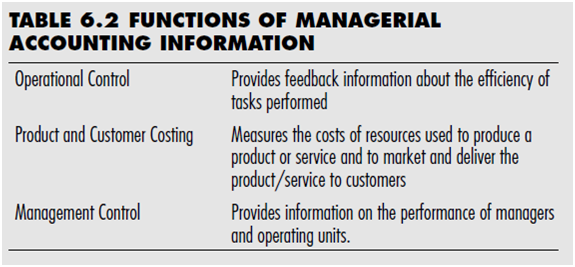Functions of Managerial Accounting
Managerial accounting data serves four functions, including (1) customer costing, (2) product costing, (3) operational control, and (4) management control. Table summarizes the important objective of each function.
The demand for managerial accounting data differs, depending on the level of the organization. At the line level, where unrefined materials or purchased parts are rehabilitated into complete products or where services are performed for clients, data is required principally to control and recover operational efficiency. That is how the organization provides a quality product at the lowest probable cost. Pertinent information here is diffuse and frequent; it is more physical and operational than financial and economic. As we move higher in an organization, where supervisory work is per- produced and decisions about products, services, and clients are made, data may be conventional less frequently but is more collective and strategic. Information at this intensity is used primarily to convey a broad picture of the organization; to present a more inclusive assessment of the business; and to identify potential difficulty areas if some characteristic of operations different from expectations.

The information needs at higher organizational levels contain summaries of transactions and events that occur at the personage employee or customer level. Here, more financial in sequence is necessary so that managers can evaluate the abundance of events happening at the prepared height of the organization. At the highest level of the organization, the information is even more strategic and less frequent. Much more of the information is now financial, with only a few key prepared variables or value-drivers used to report on significant achievement factors for the organization. Thus, managerial accounting information must be modified to meet needs at each level of a company.